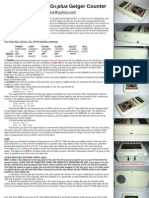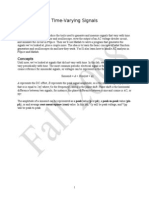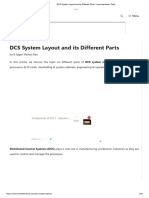32 Manual Ds 887 Ingles
32 Manual Ds 887 Ingles
Uploaded by
osvaldo dante fleitasCopyright:
Available Formats
32 Manual Ds 887 Ingles
32 Manual Ds 887 Ingles
Uploaded by
osvaldo dante fleitasOriginal Description:
Original Title
Copyright
Available Formats
Share this document
Did you find this document useful?
Is this content inappropriate?
Report this DocumentCopyright:
Available Formats
32 Manual Ds 887 Ingles
32 Manual Ds 887 Ingles
Uploaded by
osvaldo dante fleitasCopyright:
Available Formats
“DS-877” Position Indicator.
Main characteristics:
• Dual supply (VCA/ VCC).
• Lift position indicator.
• Rotatitional directional arrows.
• Failure messages indication.
• Clock.
• Optional thermometer.
• Image inversion dip programming.
• Conection with seven segment systems by optocoupler inputs (Model #: DS-877/7S. Special software).
• Overload and open doors messages indication inputs.
• Directional arrows inputs.
• 100% DS-63 and DS-7Seg. indicators compatible.
• One wire serial communication system.
• Backup battery time indication of failures in the supply line.
Supply:
The indicator can be supplied by a 12 to 24 VCA/ VCC source that allows for a 500mA current.
The connection must be made to the “Alim” terminals, with no need to worry about the polarity when it is
supplied by VCC current.
Interconection to EEC/C44, EEC/F40, EEC/C22 or EEC/F8 JYE boards:
The interconnection to EEC/C44, EEC/F40, EEC/C22 or EEC/F8 JYE boards, is done by just connecting
the 0V and the Txd terminals from those boards to the display`s 0V and S terminals.
Seven segment system operation:
To connect the display to a seven segment signalling system, it must be bared in mind that a special
programme must be solicited and the replaced display must be an ordinary anode one.
In this case, you have the A, B, C, D, E, F y G segments’ terminals appart from the auxiliary inputs, which will
show: the minus sign, terminal (-); number one for floors 10 to 19, terminal (1); and number 2 for fllors 20 to 29,
terminal (2). You will also have the SBC (overload) and the PA (open door) terminals, which will allow for
messages related to those failures to be shown. Finally, you will also have the FS (going up arrow) and the PB
(going down arrow) terminals, which will allow for the pictures of the directional arrows to be displayed/ shown.
All the inputs mentioned are activated if connected to 0V. So, the indicator`s 0V terminal has to be connected
to the controller`s 0V terminal.
Liquid crystal screen`s contrast level adjustment:
By using the adjustment preset the contrast level can be modified according to the illumination patterns inside
the cabin.
Accessories’ connection:
Basically, there are three accessories which can be connected to the display:
• The clock’s battery..
• The din-don loudspeaker that shows that the cabin has reached a certain floor.
• Interface circuit for temperature meassure.
To connect the clock`s battery you must have an interconnection wire with its corresponding terminal, which
has to be connected to the “Bat” pins in the picture, taking into cosideration the polarity indicated. The backup
voltage can be attained by using AA batteries.
The connection of the din-don loudspeaker that shows that the cabin has reached a certain floor is done in to
the terminal named: “Loudspeaker”
If you choose the terperature meassure interfase, this has to be connected to the pins arranged for that
function, taking into consideration the connection polarity.
Time clock adjustment:
To set the clock`s time there is a button that, when pressed, changes the time adding one minute. If it is kept
pressed for some seconds, the speed at which it changes from one minute to another will increase. If you
release it and then you press it again, the time will change and add one minute at a time.
Date adjustment:
To set the date (dipswitch Number 2 ‘on’), you can use the same button that you use to set the time. When
this button is pressed, it will change the date by adding one day at a time. If you keep it pressed for some
seconds, the speed at which it changes from day to day will increase and when it changes from day 31 to 1,
the month will change. If you release the button and then, you press it again, the clock will change and add one
day at a time.
Din-don circuit`s volume adjustment:
By using the adjustment preset you can change the volume of the din-don that shows that the lift has reached
a floor.
Dip-switch progamming table:
DIP Function DIP on DIP off
8 Image inversion Direct mode Inverted mode
7 Din-Don Any call Only hall calls
6 Temperature Enabled Disabled
3 and 4 Maximum capacity Choose one of the four Choose one of the four
alternatives alternatives
2 Day and month Enabled Disabled
You might also like
- Bagisto Paystack IntegrationDocument10 pagesBagisto Paystack Integrationodekunle oluwatobi alaoNo ratings yet
- B2800 Flow Monitor: Programming & Installation Manual Simplified VersionDocument20 pagesB2800 Flow Monitor: Programming & Installation Manual Simplified VersionRicardo SeguraNo ratings yet
- K31 ManualDocument3 pagesK31 ManualDavid KasaiNo ratings yet
- Prime Scales Ps-In 202Document16 pagesPrime Scales Ps-In 202José Manuel Mejía100% (1)
- DN6000 ManualDocument23 pagesDN6000 Manualpmacs10No ratings yet
- DN6000 User ManualDocument23 pagesDN6000 User ManualMarco FrigerioNo ratings yet
- K73 TEKO Plus Owner ManualDocument7 pagesK73 TEKO Plus Owner ManualDavid KasaiNo ratings yet
- DSP-10 ManualDocument2 pagesDSP-10 ManualIvan EspinosaNo ratings yet
- K89 Hiro SBT-10 ManDocument8 pagesK89 Hiro SBT-10 ManDavid KasaiNo ratings yet
- User'S Manual: Digital Multi-Function TesterDocument10 pagesUser'S Manual: Digital Multi-Function TesterLuis Angel Oviedo BermúdezNo ratings yet
- K58 ManualDocument8 pagesK58 ManualDavid KasaiNo ratings yet
- K110 Windscale+plus w/LND712p Geiger Counter: GreenDocument8 pagesK110 Windscale+plus w/LND712p Geiger Counter: GreenDavid KasaiNo ratings yet
- Ghost Pedal ManualDocument29 pagesGhost Pedal ManualCora MedinaNo ratings yet
- LEVEL METER User ManualDocument50 pagesLEVEL METER User Manualosegutv7No ratings yet
- SHARP 37DM-23H: General InformationDocument3 pagesSHARP 37DM-23H: General InformationsoyvatzogloyNo ratings yet
- 16.voltmeter Calibration Punzalan - Tuliao.dumangasDocument87 pages16.voltmeter Calibration Punzalan - Tuliao.dumangasjomar lipaopaoNo ratings yet
- RKR XXGTSDocument5 pagesRKR XXGTSahmedhassankhanNo ratings yet
- Akira CT 14sk9cp 3y11Document23 pagesAkira CT 14sk9cp 3y11HengkiNo ratings yet
- K85 Tekoplus CI-8B Owner ManualDocument7 pagesK85 Tekoplus CI-8B Owner ManualDavid KasaiNo ratings yet
- LAB1 and LAB 2Document19 pagesLAB1 and LAB 2Javeria AzeemNo ratings yet
- B2800 Flow Monitor: Programming & Installation Manual Simplified VersionDocument20 pagesB2800 Flow Monitor: Programming & Installation Manual Simplified VersionAnonymous MvVBq8QdNo ratings yet
- Lab # 1 Introduction To Instruments. (Digital Oscilloscope and Digital Function Generator) and Software LtspiceDocument23 pagesLab # 1 Introduction To Instruments. (Digital Oscilloscope and Digital Function Generator) and Software LtspiceMISBAH BATOOLNo ratings yet
- Quasar ManualDocument48 pagesQuasar ManualVikram Sen50% (8)
- Lilliput Monitor 668 InstructionsDocument15 pagesLilliput Monitor 668 InstructionsMic McNo ratings yet
- K108 GK5 712 ManDocument8 pagesK108 GK5 712 ManDavid KasaiNo ratings yet
- Computer Systems Technology Ug1 201: Peakvalue RmsDocument7 pagesComputer Systems Technology Ug1 201: Peakvalue RmsRonald MutendaNo ratings yet
- K68 ManualDocument7 pagesK68 ManualDavid KasaiNo ratings yet
- Microprocessors ProjectDocument39 pagesMicroprocessors Projectnisarg_roxNo ratings yet
- Rta Mic InputDocument4 pagesRta Mic Inputs4b3n17765No ratings yet
- K121 Windscale 2.0 W/ LND712 ManualDocument8 pagesK121 Windscale 2.0 W/ LND712 ManualDavid KasaiNo ratings yet
- User'S Manual: Digital Satellite Meter SH-500Document8 pagesUser'S Manual: Digital Satellite Meter SH-500josewanNo ratings yet
- TCL - CH - M113 (Z - TMPA8809 (TMPA8827) ) - S - ModeDocument9 pagesTCL - CH - M113 (Z - TMPA8809 (TMPA8827) ) - S - ModejosetantonioNo ratings yet
- GK B5 User Guide v12Document5 pagesGK B5 User Guide v12CarecaIIINo ratings yet
- Ams4a051 Winch Operators Display Panel RevlDocument48 pagesAms4a051 Winch Operators Display Panel Revlbaggo81No ratings yet
- STAGEDRIVE+ - Quickstart Guide - v1.3Document156 pagesSTAGEDRIVE+ - Quickstart Guide - v1.3JohnNo ratings yet
- Model 63 Electronic LCD Counter: DescriptionDocument4 pagesModel 63 Electronic LCD Counter: DescriptionCristian ZavalaNo ratings yet
- Level Control LoopDocument9 pagesLevel Control LoopHriday NathNo ratings yet
- HY-TB4DV-H Series Three-Axis ManualDocument18 pagesHY-TB4DV-H Series Three-Axis ManualMarcos AndréNo ratings yet
- Time Varying SignalsDocument17 pagesTime Varying SignalsDiego Cancino SilvaNo ratings yet
- Bentley Nevada and 21xxDocument6 pagesBentley Nevada and 21xxFallo SusiloNo ratings yet
- SPM93Document28 pagesSPM93Lauren AdolfNo ratings yet
- Akira Ct-14ns9re 3y11 ChassisDocument34 pagesAkira Ct-14ns9re 3y11 ChassisSajeeva PereraNo ratings yet
- C1200 Manual VER1.02Document27 pagesC1200 Manual VER1.02ovidiug1982No ratings yet
- FG 7000 ManualDocument8 pagesFG 7000 Manualhugo_cortes5275No ratings yet
- K35 Touchpanel ManualDocument15 pagesK35 Touchpanel ManualSamuel YipNo ratings yet
- Micron Non Contact ManualDocument15 pagesMicron Non Contact ManualJuliano Antunes de OliveiraNo ratings yet
- Samsung 940FN PDFDocument66 pagesSamsung 940FN PDFsupriyo110No ratings yet
- Instructions Manual: Unit Control Vk-30CDocument8 pagesInstructions Manual: Unit Control Vk-30Ccristino_djNo ratings yet
- Service Adjustments: 1. Adjustment Method After PWB And/or IC Replacement Due To RepairDocument12 pagesService Adjustments: 1. Adjustment Method After PWB And/or IC Replacement Due To RepairjimgoodmaNo ratings yet
- Digiair Pro User Manual V2.0.10Document10 pagesDigiair Pro User Manual V2.0.10Annie Da-BathNo ratings yet
- K112 GeigerPal MANDocument6 pagesK112 GeigerPal MANDavid KasaiNo ratings yet
- Manual Bascula - 2015PS-IN202SSDocument17 pagesManual Bascula - 2015PS-IN202SSJoaquin Fuentes MartinezNo ratings yet
- TV Orion-Sinudyne Chassis - 2550 - Professional - SCH, Service - ModeDocument13 pagesTV Orion-Sinudyne Chassis - 2550 - Professional - SCH, Service - ModetodorloncarskiNo ratings yet
- Fluke 87 V Secret MenuDocument8 pagesFluke 87 V Secret MenuMehmet Serdar TekeNo ratings yet
- KL 620 PDFDocument151 pagesKL 620 PDFFidaa JaafrahNo ratings yet
- Akira ct-21px9cp 3y11 PDFDocument41 pagesAkira ct-21px9cp 3y11 PDFAdam LiviuNo ratings yet
- EnginstDocument2 pagesEnginstPRM4515No ratings yet
- Analog Dialogue, Volume 48, Number 1: Analog Dialogue, #13From EverandAnalog Dialogue, Volume 48, Number 1: Analog Dialogue, #13Rating: 4 out of 5 stars4/5 (1)
- Fujifilm X100VI: Pocket Guide: Buttons, Dials, Settings, Modes, and Shooting TipsFrom EverandFujifilm X100VI: Pocket Guide: Buttons, Dials, Settings, Modes, and Shooting TipsNo ratings yet
- (Micro Project) : (ACADEMIC YEAR:-2020-2021)Document15 pages(Micro Project) : (ACADEMIC YEAR:-2020-2021)Krish MahorkarNo ratings yet
- Probability and Statistics UIUC LuthuliDocument451 pagesProbability and Statistics UIUC LuthuliNitin Deshpande100% (2)
- Respironics V60 Users ManualDocument160 pagesRespironics V60 Users ManualAnonymous pzadxGS2CNNo ratings yet
- Lab View 22bec108Document5 pagesLab View 22bec108Saumya KumarNo ratings yet
- Dual Band Wireless Telephone: Level 1 and 2 Service ManualDocument54 pagesDual Band Wireless Telephone: Level 1 and 2 Service ManualDaniel GabinoNo ratings yet
- Game Theoretical Motion Planning: Alessandro Zanardi, Saverio Bolognani, Andrea Censi and Emilio FrazzoliDocument47 pagesGame Theoretical Motion Planning: Alessandro Zanardi, Saverio Bolognani, Andrea Censi and Emilio Frazzolikak.isNo ratings yet
- The Bittorrent Protocol: A Peer-To-Peer File Sharing ProtocolDocument25 pagesThe Bittorrent Protocol: A Peer-To-Peer File Sharing ProtocolJayendra TiwariNo ratings yet
- Njit Ece 251 Homework SolutionsDocument4 pagesNjit Ece 251 Homework Solutionscjxksnapd100% (2)
- Microsoft Word BasicsDocument20 pagesMicrosoft Word BasicsAswin P KumarNo ratings yet
- DCS System Layout and Its Different Parts - Instrumentation ToolsDocument24 pagesDCS System Layout and Its Different Parts - Instrumentation Toolsexplorer5034No ratings yet
- SysTask V3x EDocument13 pagesSysTask V3x Emuhamad.badar9285No ratings yet
- OS Previous Year QuestionDocument99 pagesOS Previous Year QuestionDaivik ChaulkarNo ratings yet
- Saurabh Singh Cap100 CA 2Document17 pagesSaurabh Singh Cap100 CA 2saurabh singh gahlotNo ratings yet
- Lecture Two Remote Procedure CallDocument6 pagesLecture Two Remote Procedure CallEzra KenyanyaNo ratings yet
- Revision Questions For Oop2 JavaDocument5 pagesRevision Questions For Oop2 Javamahrezkouami1No ratings yet
- CT026-3-2 Human Computer Interaction Incourse QuestionDocument7 pagesCT026-3-2 Human Computer Interaction Incourse Questionjames smithNo ratings yet
- 外语教学定量研究方法及数据分析 2nd Edition 秦晓晴 毕劲 download PDFDocument59 pages外语教学定量研究方法及数据分析 2nd Edition 秦晓晴 毕劲 download PDFhanufqianyi100% (4)
- Hay Day Characters - Google SearchDocument1 pageHay Day Characters - Google Searchgrocthecroc1No ratings yet
- Decision and Game Theory For SecurityDocument479 pagesDecision and Game Theory For Securityjdalvaran100% (1)
- 3 3 1 P 604768e05c821 FileDocument12 pages3 3 1 P 604768e05c821 FileKunal AhiwaleNo ratings yet
- Welcome To The FMEA Worksheet: This Spreadsheet Can Be Used ToDocument26 pagesWelcome To The FMEA Worksheet: This Spreadsheet Can Be Used ToKailash PandeyNo ratings yet
- WEB TECHNOLOGY LABORATORY MANUAL (2020) - For StudentsDocument39 pagesWEB TECHNOLOGY LABORATORY MANUAL (2020) - For StudentsShilpaNo ratings yet
- PARAMETROS ABB BEAM1xlsxDocument8 pagesPARAMETROS ABB BEAM1xlsxsergio eduardo siderol jimenezNo ratings yet
- LFM Portfolio Brochure PDFDocument8 pagesLFM Portfolio Brochure PDFHamidReza GholamianNo ratings yet
- G7 - Q1 - TLE - ICT - Lesson Exemplar - Week 4Document12 pagesG7 - Q1 - TLE - ICT - Lesson Exemplar - Week 4Thess Gee100% (2)
- Download pdf Implementing Sap Business Suite On Sap Hana Prepare And Execute A Migration Of Sap Business Suite From Any Db To Sap Hana Understand How To Test And Monitor Your New System Once Live Learn How To Opti ebook full chapterDocument52 pagesDownload pdf Implementing Sap Business Suite On Sap Hana Prepare And Execute A Migration Of Sap Business Suite From Any Db To Sap Hana Understand How To Test And Monitor Your New System Once Live Learn How To Opti ebook full chapterjeannette.king876100% (3)
- IUL SPIN AIR V2 User GuideDocument24 pagesIUL SPIN AIR V2 User GuideDavidNo ratings yet
- SedraSmith8e Chapter 04 SpiceProblemGuideDocument5 pagesSedraSmith8e Chapter 04 SpiceProblemGuide辰.No ratings yet
- Mapping The LedgerTrans Table To General Journal Tables AX2012Document8 pagesMapping The LedgerTrans Table To General Journal Tables AX2012Zuleide C SilvaNo ratings yet

























































































